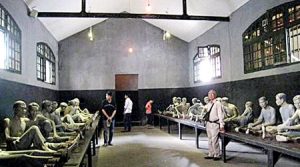The term Hoa Lo, commonly interpreted as “fiery furnace” or “Hell’s hole,” also carries the meaning of “stove.” Its origins lie in the street name “Pho Hoa Lo,” named due to the concentration of shops selling wood stoves and coal-fire stoves along the street from pre-colonial times.
Constructed in Hanoi by the French between 1886 and 1889 to 1898 and 1901, during Vietnam’s association with French Indochina, the prison was referred to as Maison Centrale, a conventional euphemism for prisons in France. Situated near Hanoi’s French Quarter, it was designed to detain Vietnamese prisoners, particularly political activists advocating for independence, who were frequently subjected to torture and execution. In 1913, renovations expanded its capacity from 460 inmates to 600. Despite this, it remained overcrowded, reaching a peak of 1,430 prisoners in 1933. By 1954, holding over 2000 people, it had become a symbol of colonialist exploitation and Vietnamese resentment towards the French.
Popularly known as the ‘Hanoi Hilton’ during the Second Indochina War, Hoa Lo Prison was initially established in 1896 by the French colonial government to house political prisoners. It was part of a network of ‘unjust and cruel prisons’ in the north, including Cao Bang, Son La, Lai Chau, and Hai Phong. Many prominent revolutionaries, such as Phan Boi Chau, Hoang Trong Mau, Luong Van Can, Nguyen Quyen, Nguyen Luong Bang, and five future General Secretaries of the Communist Party, were incarcerated here during the French colonial period. Between 1964 and 1973, American pilots, including Senator John McCain and Douglas ‘Pete’ Peterson, were also held captive.
Although most of the original prison was demolished in 1996 to make way for the Hanoi Towers, the southernmost corner has been preserved as a memorial to the revolutionaries who suffered in appalling conditions. Visitors can explore original cells with leg-irons and bilingual displays depicting the horrors of life during the French colonial era.
Conditions within the prison were deplorable, with watery soup and bread as meager sustenance. Prisoners faced isolation, starvation, beatings, and torture, and were subjected to anti-American propaganda. The prison earned the reputation of being “A Hell on Earth.”
Portrayed in the 1987 Hollywood film “The Hanoi Hilton,” the site underwent significant changes in 1996, with most walls torn down for new construction. Remaining portions were retained for historical significance, and by 1998, the old front of the prison was restored and turned into a tourist site. The Hilton Hanoi Opera Hotel, built in 1999, carefully avoided reusing the dreaded name “Hanoi Hilton.”
Hoa Lo Prison stands as a historical attraction for both local and foreign visitors. A visit to the prison allows firsthand exploration of its tumultuous history and the conditions endured by those within its walls.




